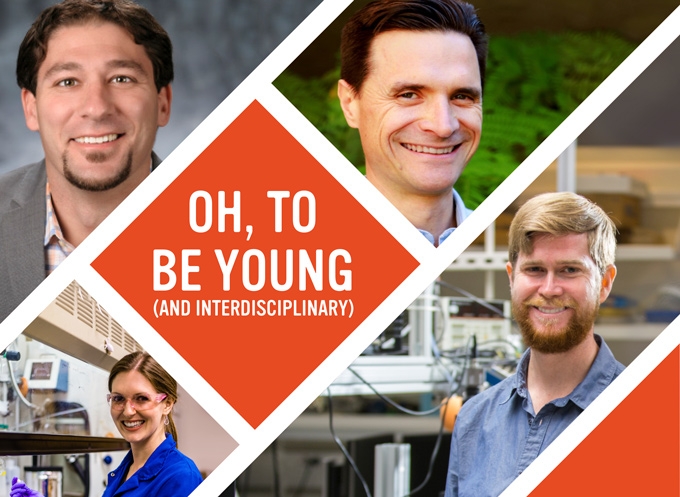Students are among those who benefit most from the collaborative orientation of engineering and the sciences at UC Santa Barbara. Graduate students, especially, gain a great advantage from being co-advised by multiple faculty members in different departments, exposing them to a broad range of perspectives, knowledge, tools, and techniques. And because UCSB lacks the kind of research fiefdoms common at many universities, students become part of a dynamic collaborative exchange with their fellow graduate students. As a result, graduate students, who are on the front lines of research, regularly provide key insights and breakthroughs.
“Our students are better at collaboration when they graduate from UCSB because they create their own identity,” says computational engineer and materials professor Anton Van Der Ven. “They’re not a clone of one professor. They synthesize something new from two or three groups. Co-advising students enriches the whole endeavor, and as professors guiding students who are unafraid to try to merge completely different fields, we absorb new insights and ways of thinking from them all the time.”
Kaila Mattson (PhD ’16), a chemist at The Dow Chemical Company in Michigan, echoes that view. During her time at UCSB, she had an office in the highly collaborative Materials Research Laboratory. “The open-door policy that all faculty had was a tremendous boon,” she says. “Every professor I interacted with was more than willing to sit down and answer my questions about science and see if they could provide insights, even if I wasn’t in their group.”
There are few, if any, barriers to prevent students from spending time with a lab group they are not officially affiliated with in order to learn something important to their research. That freedom to make choices and follow their curiosity allows them to gain both knowledge and confidence in their own resourcefulness.
“Students appreciate all the skill sets and tools that are taught in different disciplines,” says chemical engineering professor Glenn Fredrickson. “I have students from chemical engineering and occasionally from materials, physics, and chemistry. They’re all getting PhDs and comparing notes on what courses they take and what they’re learning. They learn from each other all the time.”
Jonathan Klamkin, assistant professor in the Department of Electrical and Chemical Engineering, earned his PhD at UCSB (Professor Emeritus Larry Coldren was his advisor) but is also familiar with what he refers to as “the traditional university model in the U.S., where professors have their own labs and the door’s closed, and it’s not as collaborative.”
At UCSB, he says, “It’s different. We work on really tough projects that one person can’t do alone. Students work together, and the net product is something they all benefit from, not just because it’s so cutting edge, but also because they learned to work together.” Citing that familiarity with collaborative group work, he adds, “There’s definitely a concentration of UCSB graduates in industry, because they’re productive and entrepreneurial and know how to work as a team to make a finished product.”
Mechanical engineering PhD student Luke Patterson, who is part of the micro-hammer collaboration (see page 17), recalls that when he visited UCSB as a prospective student, “I had a sense that everyone was very serious about their research but not in a territorial way. People seemed completely open to discussing their ideas and working together. It’s a big reason why I came here.”
The team approach has also extended his ability to contribute. For instance, after doing some cell work himself when a fellow student was away, he became more aware of how long the procedure he was doing takes and what, therefore, is a reasonable number of proteins to ask others to test for. “There’s an advantage to being able to speak multiple languages,” he says. “I can talk intelligently with my biology collaborators and understand what they’re saying, but I can also provide better input.”
“Working collaboratively, you can tackle larger and more-complex challenges,” Mattson notes. “I was trained as synthetic chemist, and my core competency is creating new molecules. But that work is much more powerful if I team up with someone in engineering who can see ways to use them in applications that might be beyond my core competency. It takes the research so much further. I notice that colleagues who take a more siloed approach are less efficient and can lack such richness in their science.”
For mechanical engineering professor Megan Valentine, giving students the opportunity to partner pays multiple dividends. “Student training is better if they have access to multiple faculty and are given the incentive and the freedom to be creative, to ask questions beyond the boundary of one group,” she explains. “Students are at ground zero. They know a lot of other students. They know a lot of faculty, and if you can give them the agency to think collaboratively, they can bring things to the table that we might not see. And that’s the way it should be. It’s good training for them, and we get better science.

They’ve learned to collaborate (clockwise from center left): Kaila Mattson, Jonathan Klamkin, Anton Van Der Ven, Luke Patterson
